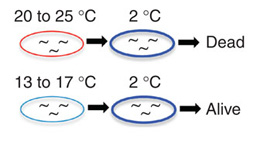Research Abstract
光とフェロモンを感知するニューロンが、インスリンシグナル伝達を介して線虫の低温への適応を調節する
Light and pheromone-sensing neurons regulates cold habituation through insulin signalling in Caenorhabditis elegant
2014年7月22日 Nature Communications 5 : 4412 doi: 10.1038/ncomms5412

温度は、生体内の生化学的反応に強く影響を与える重要な環境刺激である。動物は環境の温度変化に、行動や体内の生理学的性質を変化させることにより応答することができる。しかし、動物が温度に適応する仕組みについては十分には分かっていない。線虫の一種であるCaenorhabditis elegansでは、温度変化を経験するとそれが記憶され、温度適応(低温耐性)が引き起こされる。本論文では、光とフェロモンを感知するニューロンであるASJが、インスリンシグナル伝達を介して低温への適応を調節していることを示す。カルシウムイメージング法によって、ASJニューロンが温度に応答することが明らかとなった。ASJニューロンにおけるcGMPシグナル伝達が欠損している変異体では、低温適応に異常が見られた。ASJニューロンから放出されるインスリンは、腸やニューロンで受容され、低温への適応に関わる遺伝子発現を調節することが示唆された。これらの結果より、光とフェロモンを感知するニューロンが温度を感知し、インスリンシグナル伝達に作用することで、経験に依存した温度適応を制御する。
太田 茜1, 宇治澤 知代1, 園田 悟1 & 久原 篤1
- 甲南大学大学院 自然科学研究科 生体調節学 / 統合ニューロバイオロジー研究
Temperature is a critical environmental stimulus that has a strong impact on an organism’s biochemistry. Animals can respond to changes in ambient temperature through behaviour or altered physiology. However, how animals habituate to temperature is poorly understood. The nematode C. elegans stores temperature experiences and can induce temperature habituation-linked cold tolerance. Here we show that light and pheromone-sensing neurons (ASJ) regulate cold habituation through insulin signalling. Calcium imaging reveals that ASJ neurons respond to temperature. Cold habituation is abnormal in a mutant with impaired cGMP signalling in ASJ neurons. Insulin released from ASJ neurons is received by the intestine and neurons regulating gene expression for cold habituation. Thus, temperature sensation in a light and pheromone-sensing neuron produces a robust effect on insulin signalling that controls experience-dependent temperature habituation.

